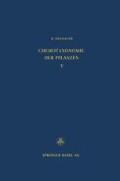Zusammenfassung
Überwiegend holzige, oft mit Ranken klimmende Pflanzen mit wechselständigen, ganzrandigen oder mehr oder weniger eingeschnittenen Blättern mit Nebenblättern. Blüten meist gross, zwittrig oder eingeschlechtig, aktinomorph, mit einem durch Brakteen und Brakteolen gebildeten kelchartigen Involucrum und mit mannigfach gestaltetem, oft hohlem Blütenboden, der innerhalb der Kronblätter eine oder mehrere Nebenkronen (Coronae) trägt. Kelch und Krone meist 5blättrig, die letztere zuweilen fehlend; oft beide korollinisch, frei oder am Grunde verwachsen. Staubblätter 5 (oder mehr) auf dem Blütenboden oder auf einem Androgynophor (Passiflora) stehend. Fruchtknoten kürzer oder länger gestielt (Gynophor oder Androgynophor), einfächerig mit meist 3 parietalen Plazenten mit zahlreichen Samenanlagen mit je 2 Integumenten. Kapsel- oder Beerenfrüchte. Samen meist mit Arillus und mit reichlich Endosperm.
Access this chapter
Tax calculation will be finalised at checkout
Purchases are for personal use only
Preview
Unable to display preview. Download preview PDF.
Literatur
Ambühl, H.,Anatomische und chemische Untersuchungen an Passiflora coerulea L. und P. incarnata L.,Diss., ETH. Zürich, 1966.
Brooker, S. G., Trans. Roy. Soc. New Zealand 88,158 (1960).
Dekker, J., Pharm. Weekblad 43,942 (1906).
Fellows, E. J., und Smith, C. S.,J. Am. Pharm. Assoc. 27,565 (1938); vgl. ebenfalls
G. H. Ruggy und C. S. Smith, ibid. 29,207 (1940).
Fickendey, E. Z., Angew. Chemie 23,2167 (1910).
Green, H.,und Andrews, W. H., 9th and 10th Rep. Director Vet. Educ. and Research (Pretoria) 1923, S. 381.
Guignard, L.,Bull. Sci. Pharmacol. 13,603 (1906).
Hultin, E., Acta Chem. Scand. 19,1431 (1965).
Lawrence, G.H. M.,Identification of cultivated passion flowers, Baileya 8,121–132 (1960).
Lutomski, J., Biul. Inst. Roslin Leczniczych 5, 197 (1959); 6,209 (1960); Herba Polon. 13,44 (1967).
Meyer, G., und Pernet, r.,Le Naturaliste Malgache 9,203 (1957).
Mollenhauer, H. P., Die Grenadilla,Deut. Apoth. Z. 102, 1097 (1962).
Neu, R., Arzneimittelforschung 4, 601 (1954); d, 94 (1956).
Neugebauer, H., Pharmazie 4, 176 (1949).
Peckolt, TH., Ber. Deut. Pharm. Ges. 19,343 (1909).
Petrie, J. M., Proc. Linn. Soc. N. S. Wales 37,220 (1912); 42,113 (1917).
Plouvier, V., Bull. Sci. Pharmacol. 49,48 (1942); Compt. Rend. 247,2423 (1958).
Pruthi, J. S., J. Sci. Ind. Research (India) 17B,238 (1958); Physiology, Chemistry and Technology of Passion Fruit,Adv. in Food Research 12,203–282 (1963).
Sack, J., Pharm. Weekblad 48,311 (1911).
Schindler, H., Arzneimittelforschung 5, 491 (1955).
Smith, F., und White, C. T., Proc. Roy. Soc. Queensland 30,84 (1918).
Steyn, D.G., 15th Rep. Director Vet. Serv. Union of South Africa 1929, Vol. II, Sect. VI, S. 799.
Treub, M., Ann. Jard. Botan. Buitenzorg [2] 6,80 (1907);8, 85 (1909).
Author information
Authors and Affiliations
Rights and permissions
Copyright information
© 1969 Springer Basel AG
About this chapter
Cite this chapter
Hegnauer, R. (1969). Passifloraceae. In: Chemotaxonomie der Pflanzen. Chemische Reihe Band 20: Lehrbücher und Monographien aus dem Gebiete der Exakten Wissenschaften, vol 20. Birkhäuser, Basel. https://doi.org/10.1007/978-3-0348-9381-7_40
Download citation
DOI: https://doi.org/10.1007/978-3-0348-9381-7_40
Publisher Name: Birkhäuser, Basel
Print ISBN: 978-3-0348-9382-4
Online ISBN: 978-3-0348-9381-7
eBook Packages: Springer Book Archive

